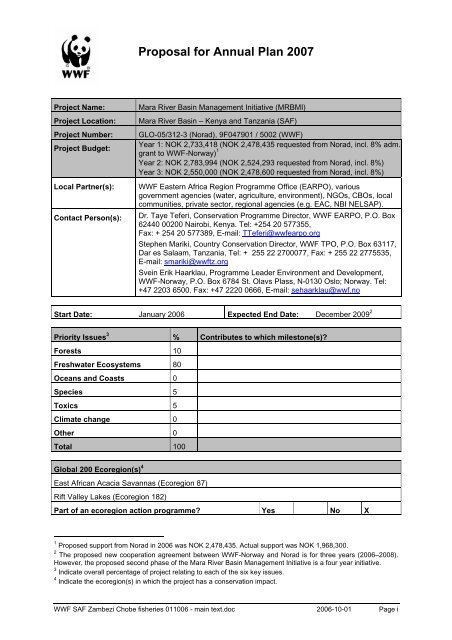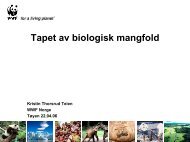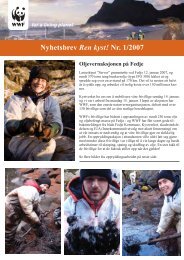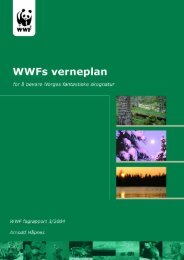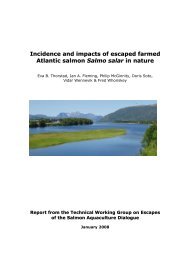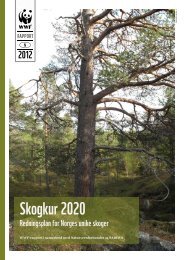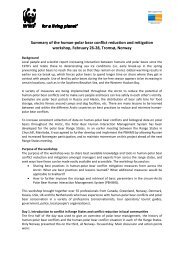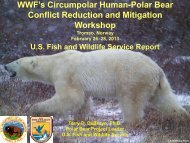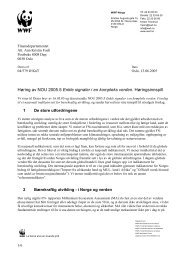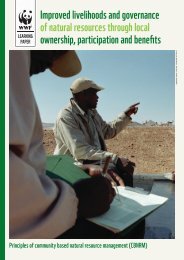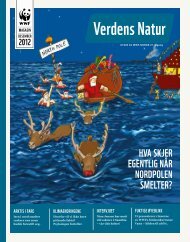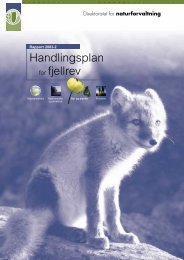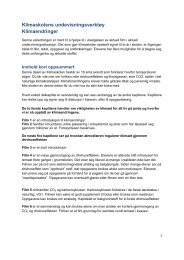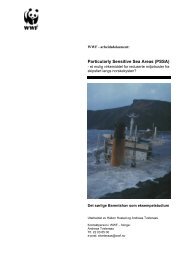WWF SAF Mara River Basin Project Proposal
WWF SAF Mara River Basin Project Proposal
WWF SAF Mara River Basin Project Proposal
You also want an ePaper? Increase the reach of your titles
YUMPU automatically turns print PDFs into web optimized ePapers that Google loves.
<strong>Proposal</strong> for Annual Plan 2007<br />
<strong>Project</strong> Name:<br />
<strong>Project</strong> Location:<br />
<strong>Project</strong> Number:<br />
<strong>Project</strong> Budget:<br />
Local Partner(s):<br />
Contact Person(s):<br />
<strong>Mara</strong> <strong>River</strong> <strong>Basin</strong> Management Initiative (MRBMI)<br />
<strong>Mara</strong> <strong>River</strong> <strong>Basin</strong> – Kenya and Tanzania (<strong>SAF</strong>)<br />
GLO-05/312-3 (Norad), 9F047901 / 5002 (<strong>WWF</strong>)<br />
Year 1: NOK 2,733,418 (NOK 2,478,435 requested from Norad, incl. 8% adm.<br />
grant to <strong>WWF</strong>-Norway) 1<br />
Year 2: NOK 2,783,994 (NOK 2,524,293 requested from Norad, incl. 8%)<br />
Year 3: NOK 2,550,000 (NOK 2,478,600 requested from Norad, incl. 8%)<br />
<strong>WWF</strong> Eastern Africa Region Programme Office (EARPO), various<br />
government agencies (water, agriculture, environment), NGOs, CBOs, local<br />
communities, private sector, regional agencies (e.g. EAC, NBI NELSAP).<br />
Dr. Taye Teferi, Conservation Programme Director, <strong>WWF</strong> EARPO, P.O. Box<br />
62440 00200 Nairobi, Kenya. Tel: +254 20 577355,<br />
Fax: + 254 20 577389, E-mail: TTeferi@wwfearpo.org<br />
Stephen Mariki, Country Conservation Director, <strong>WWF</strong> TPO, P.O. Box 63117,<br />
Dar es Salaam, Tanzania, Tel: + 255 22 2700077, Fax: + 255 22 2775535,<br />
E-mail: smariki@wwftz.org<br />
Svein Erik Haarklau, Programme Leader Environment and Development,<br />
<strong>WWF</strong>-Norway, P.O. Box 6784 St. Olavs Plass, N-0130 Oslo; Norway. Tel:<br />
+47 2203 6500. Fax: +47 2220 0666, E-mail: sehaarklau@wwf.no<br />
Start Date: January 2006 Expected End Date: December 2009 2<br />
Priority Issues 3 % Contributes to which milestone(s)?<br />
Forests 10<br />
Freshwater Ecosystems 80<br />
Oceans and Coasts 0<br />
Species 5<br />
Toxics 5<br />
Climate change 0<br />
Other 0<br />
Total 100<br />
Global 200 Ecoregion(s) 4<br />
East African Acacia Savannas (Ecoregion 87)<br />
Rift Valley Lakes (Ecoregion 182)<br />
Part of an ecoregion action programme? Yes No X<br />
1 Proposed support from Norad in 2006 was NOK 2,478,435. Actual support was NOK 1,968,300.<br />
2 The proposed new cooperation agreement between <strong>WWF</strong>-Norway and Norad is for three years (2006–2008).<br />
However, the proposed second phase of the <strong>Mara</strong> <strong>River</strong> <strong>Basin</strong> Management Initiative is a four year initiative.<br />
3 Indicate overall percentage of project relating to each of the six key issues.<br />
4 Indicate the ecoregion(s) in which the project has a conservation impact.<br />
<strong>WWF</strong> <strong>SAF</strong> Zambezi Chobe fisheries 011006 - main text.doc 2006-10-01 Page i
<strong>WWF</strong><br />
Annual Plan 2007 – <strong>Mara</strong> <strong>River</strong> <strong>Basin</strong> Management Initiative<br />
EXECUTIVE SUMMARY<br />
This <strong>Proposal</strong> is part of the approved three years document for the <strong>Mara</strong> <strong>River</strong> <strong>Basin</strong><br />
Management Initiative, Kenya and Tanzania (“the <strong>Project</strong>”) submitted to the Norwegian Agency<br />
for Development Cooperation (Norad) for funding. <strong>WWF</strong>-Norway contributes with matching funds.<br />
The four years second phase of the <strong>Mara</strong> <strong>River</strong> <strong>Basin</strong> Management Initiative (MRBMI) started in<br />
January 2006 and will end in December 2009. This is in line with the recommendations of an<br />
evaluation of the <strong>Project</strong> conducted in May–June 2005. The second phase will consolidate<br />
Norad/<strong>WWF</strong> Norway’s investments in the past three years (2003–2005) and continue to facilitate<br />
a system for integrated water resources management. The USAID Bureau for Economic Growth,<br />
Agriculture and Trade (EGAT) and USAID East Africa also contribute funds to the MRBMI in<br />
2007. One common work plan is prepared for MRBMI, indicating which source of funding<br />
supports each activity.<br />
Background<br />
Detailed background information on the <strong>Mara</strong> <strong>River</strong> <strong>Basin</strong> was provided in the proposal submitted<br />
to Norad in October 2002 and subsequent annual plans as well as the main text of this proposal.<br />
During 2005 <strong>WWF</strong> commissioned an evaluation of the MRBMI, which concluded that the MRBMI<br />
has made significant contributions to the sustainable management of the <strong>Mara</strong> <strong>River</strong> <strong>Basin</strong> that<br />
also had attracted the interest of other donors. The evaluation observed that the <strong>Project</strong> is highly<br />
relevant in view of the major threats both to the <strong>Mara</strong> <strong>River</strong> and its tributaries, and to the tourist<br />
industry in the National Park (Serengeti, Tanzania) and National Reserve (Masai <strong>Mara</strong>, Kenya)<br />
that largely depends on the <strong>River</strong>. In terms of project progress the evaluation team considered<br />
the principal achievements of the <strong>Project</strong> to be:<br />
i. The lobbying of political leaders for the protection of the remaining forest in the upper<br />
catchment (Mau Forest) in Kenya, the source for the <strong>Mara</strong> <strong>River</strong>;<br />
ii.<br />
iii.<br />
iv.<br />
The facilitation of the <strong>Mara</strong> <strong>River</strong> Water Users’ Association (MRWUA), a large and<br />
representative forum for discussion on water and related issues in the Kenyan part of the<br />
<strong>Mara</strong> <strong>River</strong> <strong>Basin</strong>. Facilitation of about 20 local level water users’ associations in<br />
Tanzania;<br />
Successful lobbying of civic leaders leading to a proposed sewage treatment plant in<br />
Bomet Town. The Ministry of Water and Irrigation has prioritized this project as one of<br />
the investment projects under the NBI NELSAP <strong>Mara</strong> <strong>River</strong> IWRM project; and<br />
The fact that the Ministry of Water and Irrigation in Kenya perceives the MRBMI as a pilot<br />
project for implementing the new water sector legislation and institutional framework.<br />
<strong>WWF</strong> is working through its Eastern Africa Regional Programme Office (<strong>WWF</strong> EARPO) and with<br />
financial support from Norad/<strong>WWF</strong>-Norway and USAID, to create the enabling conditions for<br />
integrated water resources management (IWRM) and to facilitate the efforts of responsible<br />
government agencies, other partners and stakeholders to implement IWRM.<br />
The main achievements of the MRBMI in 2006 are grouped into three areas as follows:<br />
i. Coordination of <strong>WWF</strong> and other key Stakeholders Initiatives<br />
An evaluation in June 2005 pointed out lack of coherence in the activities of the <strong>Project</strong> in Kenya<br />
and Tanzania, and also with other actors in the <strong>Basin</strong> including the Nile Equatorial Lakes<br />
Subsidiary Action Program (NELSAP) and the East Africa Community (EAC). The <strong>Project</strong> has<br />
continued efforts to engage other initiatives and followed up on this recommendation by instituting<br />
remedial measures including recruitment of two more staff and strategic engagement with the<br />
EAC and NELSAP. Two key personnel, a Policy Officer and a Regional <strong>Mara</strong> <strong>River</strong> <strong>Basin</strong><br />
Coordinator were recruited to assist the coordination and management of <strong>WWF</strong>’s initiatives and<br />
other initiatives within <strong>Mara</strong> <strong>River</strong> <strong>Basin</strong>. Different projects plans funded by Norad/<strong>WWF</strong>-Norway<br />
and USAID were integrated into one <strong>Mara</strong> <strong>River</strong> <strong>Basin</strong> Management Initiative to create more<br />
complementarities and synergy.<br />
<strong>WWF</strong> <strong>SAF</strong> Zambezi Chobe fisheries 011006 - main text.doc 2006-10-01 Page ii
<strong>WWF</strong><br />
Annual Plan 2007 – <strong>Mara</strong> <strong>River</strong> <strong>Basin</strong> Management Initiative<br />
The MRBMI also undertook further consultation with East African Community / Lake Victoria<br />
<strong>Basin</strong> Commission, District officials, Water Authority Officers both in Tanzania and Kenya on the<br />
sustainable management of <strong>Mara</strong> <strong>River</strong>. Substantial efforts were made towards collaboration with<br />
Nile <strong>Basin</strong> Initiative (NBI) Nile Equatorial Lakes Subsidiary Action Programme (NELSAP) in the<br />
management of <strong>Mara</strong> <strong>River</strong> <strong>Basin</strong>. One of the milestones was on sharing of information and<br />
clearly defined areas of collaboration and modalities. Major progress has been made recently, in<br />
particular in terms of information sharing.<br />
Efforts towards management of the <strong>Mara</strong> <strong>River</strong> <strong>Basin</strong> as a transboundary ecosystem shared by<br />
the United Republic of Tanzania and Republic of Kenya have started. The <strong>Mara</strong> <strong>River</strong> <strong>Basin</strong><br />
Management initiative provided support to EAC to organise and host a successful regional<br />
workshop in Arusha, Tanzania, between 19 th and 20 th April, 2006. The outputs of the workshops<br />
included proposals for national and regional stakeholders’ coordination mechanisms, regional<br />
institutions here including MRBMI Technical committee, Water User Forum Steering committee to<br />
oversee the implementation and build synergies within <strong>Mara</strong> <strong>River</strong> <strong>Basin</strong> Initiatives, and to avoid<br />
duplications.<br />
ii. Conserving <strong>Mara</strong> <strong>River</strong> <strong>Basin</strong> and ecoregion<br />
A number of studies have shown that the single largest threat to biodiversity in the Masai <strong>Mara</strong><br />
National Reserve and Serengeti National Park is lack of sufficient quantity of water of good<br />
quality. <strong>Mara</strong> <strong>River</strong> is the most reliable source of water for these two protected areas and the<br />
fluctuations in the river flow have significant impact on biodiversity, particularly the large<br />
herbivores. The world famous annual migration of wildebeest and other herbivores is heavily<br />
influenced by changes in water quantity (availability).<br />
Water quantity (level) and quality monitoring was carried out in 15 stations as planned in both<br />
Tanzania and Kenya. Two gauging stations were rehabilitated and other 13 stations serviced and<br />
maintained. The Ministries of water in Tanzania and Kenya were facilitated to collect and analyse<br />
water quality samples from 15 baseline monitoring stations established on the <strong>Mara</strong> <strong>River</strong> and its<br />
major tributaries.<br />
Photo: Water quality sampling point in the <strong>Mara</strong> <strong>River</strong>.<br />
<strong>WWF</strong> EARPO organised a planning workshop on Environmental Flows Assessment (EFA) with<br />
participation of different experts in hydrology, riparian vegetation, fish, aquatic invertebrates,<br />
socio-economics, hydraulics, ecology and geomorphology. The workshop came up with a<br />
common method of data collection to determine the amount of water needed to maintain the<br />
ecology of the river and the great <strong>Mara</strong>-Serengeti ecoregion. Data collection will be done within 8<br />
months, and data analysis will be completed by February 2007.<br />
<strong>WWF</strong> <strong>SAF</strong> Zambezi Chobe fisheries 011006 - main text.doc 2006-10-01 Page iii
<strong>WWF</strong><br />
Annual Plan 2007 – <strong>Mara</strong> <strong>River</strong> <strong>Basin</strong> Management Initiative<br />
iii.<br />
Sustainable water management<br />
The MRBMI used the opportunity of the new Water Act (2002) in Kenya, which provides for<br />
gazettement of water catchment areas. The MRBMI worked with the <strong>Mara</strong> Water Resource Users<br />
Association under the umbrella of the Lake Victoria South Catchment Authority (LVSCA) in Kenya<br />
to start the process of gazettement of the catchment forest. The LVSCA, under which the <strong>Mara</strong><br />
<strong>River</strong> <strong>Basin</strong> falls, has prioritised the gazettement of the catchment forest and is in the process of<br />
taking the necessary steps for the same. If successfully carried out, this will go a long way in<br />
protecting the threatened indigenous catchment forest which forms the head waters of the <strong>Mara</strong><br />
<strong>River</strong> and its tributaries. Stakeholders are highly sensitised about this, and are pushing for the<br />
process to advance as necessary. In Kenya one Water Users’Association has been formed and is<br />
legally empowered, while in Tanzania 12 water management entities (Water Users Associations)<br />
were formed and trained on IRBM and IWRM. Capacity building sessions on the water related<br />
laws and legislations were conducted with villagers and decision-makers. Water Users’<br />
Associations were facilitated in the planning and management of water resources. The<br />
established water resources management institutions have provided a platform for stakeholders<br />
in the two countries to talk to each other, and work on transboundary management strategies.<br />
The concept of water thirsty crops is now also better understood by stakeholders in the Kenya<br />
part of <strong>Mara</strong> <strong>River</strong> <strong>Basin</strong>. They now know that irrigated crops can represent a threat to the waters<br />
of the <strong>Mara</strong>, and must be considered carefully. Pressure has mounted on the large-scale farmers<br />
involved in irrigation and the conditions for venturing into irrigated agriculture are now very strict<br />
and clear. For the first time in the history of the Narok District in Kenya, irrigation was banned at<br />
the peak of the drought in February 2006 until the rains set in and there was sufficient water in<br />
the rivers.<br />
A total of 24 Community Based Organisations (CBOs) engaged in Income Generating Activities<br />
(IGA) and technologies to support livelihood and sustainable natural resources use and<br />
conservation were trained.<br />
Justification<br />
Development indicators for the Lake Victoria <strong>Basin</strong> show that poverty levels in the <strong>Mara</strong> <strong>River</strong><br />
<strong>Basin</strong>, an important part of the Lake Victoria <strong>Basin</strong>, are higher than the national averages. Most<br />
of the people practise subsistence agriculture with more than 25 per cent of them living on less<br />
than USD 1 a day. The apparent degradation of the quality and quantity of the <strong>Mara</strong> <strong>River</strong><br />
<strong>Basin</strong>’s water resources and the poverty level as well as life quality of the inhabitants are<br />
intimately linked. Left uncorrected, the continuing degradation of the <strong>Basin</strong> will worsen the<br />
livelihoods of these poor people as well as the viability of the rich biodiversity of flora and fauna in<br />
the <strong>Mara</strong> <strong>River</strong> <strong>Basin</strong>. Severe impacts on Masai <strong>Mara</strong> and Serengeti will be an ecological disaster<br />
as well as an economic disaster for Kenya’s and Tanzania’s tourism income. With properly<br />
designed and implemented interventions, the natural resources of the <strong>Basin</strong> provide opportunities<br />
for the communities to secure their livelihoods.<br />
Kenya and Tanzania are at different stages of implementing water sector reforms. The <strong>Project</strong> will<br />
contribute to the operationalisation of these reforms in a way that ensures traditional groups in<br />
the <strong>Mara</strong> <strong>River</strong> <strong>Basin</strong> are empowered to protect their rights, businesses continue to generate<br />
profits in ways that are environmentally sound while national governments place an economic<br />
value on water. The <strong>Project</strong> will support the evolution of appropriate institutions in this respect.<br />
Key stakeholders have limited capacity to do this on their own and there is a lack of information<br />
and relevant experience in the region. Stakeholders want <strong>WWF</strong> to support them to establish a<br />
sound system for water resources management.<br />
The <strong>Project</strong> will facilitate stakeholders to develop an integrated framework for the management of<br />
the <strong>Mara</strong> <strong>River</strong> <strong>Basin</strong> and its water resources by serving as a catalytic agent for bringing the<br />
various stakeholders to the discussion table to exchange ideas (dialogue) and information for<br />
planning and implementing shared sustainable management and conservation initiatives in for<br />
the <strong>Mara</strong> <strong>River</strong> <strong>Basin</strong>. <strong>WWF</strong> is working closely with government and non-government partners to<br />
do this.<br />
<strong>WWF</strong> <strong>SAF</strong> Zambezi Chobe fisheries 011006 - main text.doc 2006-10-01 Page iv
<strong>WWF</strong><br />
Annual Plan 2007 – <strong>Mara</strong> <strong>River</strong> <strong>Basin</strong> Management Initiative<br />
In both Kenya and Tanzania, the <strong>Mara</strong> <strong>River</strong> <strong>Basin</strong> and its natural resources face major threats,<br />
including deforestation, water pollution, drainage of wetlands, land use changes, and poor<br />
management and weak governance relating to natural resources.<br />
The <strong>Project</strong> will contribute to work in relation to national policies and legislation, international<br />
environmental conventions and to regional initiatives such as the East Africa Community (EAC)’s<br />
“Protocol for Sustainable Development of Lake Victoria <strong>Basin</strong>” and the Nile <strong>Basin</strong> Initiative (NBI)<br />
Nile Equatorial Lakes Subsidiary Action Programme (NELSAP) <strong>Mara</strong> <strong>River</strong> <strong>Basin</strong> Initiative.<br />
The <strong>Project</strong> is well placed within the overall priorities of Norwegian development cooperation as<br />
well as within the specific priorities for the region and countries concerned.<br />
Previous experiences<br />
During the first project phase stakeholders acknowledged that the <strong>WWF</strong> <strong>Mara</strong> <strong>River</strong> <strong>Basin</strong><br />
Management Initiative has made important progress both in Kenya and Tanzania. However,<br />
during this initial phase, most investments were done in the upstream Kenyan areas of the <strong>Basin</strong>.<br />
An assessment of the <strong>Project</strong>’s achievements is shown in the analysis of the project’s Logframe<br />
for January – December 2005 (see main text of the document). The 2005 evaluation also<br />
provides important information about the previous experiences.<br />
Goal and purpose<br />
The <strong>Project</strong>’s overall goal of the MRBMI is:<br />
‘Ensure good quality and adequate water supply from the <strong>Mara</strong> <strong>River</strong> for<br />
sustainable ecosystem functioning and basic human needs’.<br />
The project purpose is:<br />
‘to facilitate participatory and sustainable integrated river basin management<br />
(IRBM) initiatives for the conservation, sustainable and equitable use and<br />
restoration of freshwater resources and ecological processes in the <strong>Mara</strong> <strong>River</strong><br />
<strong>Basin</strong>, and this should be resulting from conservation measures, sustainable<br />
use and land-use decisions taken by resource owners, users and developers<br />
under a supportive policy framework’.<br />
Outputs<br />
The <strong>Project</strong> will contribute to the above goal and achieve its purpose by delivering on the<br />
following outputs:<br />
i. Carry out baseline surveys and as far as possible fill information gaps with<br />
documentation in the form of reports, maps etc;<br />
ii.<br />
iii.<br />
Gather and disseminate appropriate information on conditions and threats to the <strong>Mara</strong><br />
<strong>River</strong> <strong>Basin</strong> for land-use planning and management of the <strong>Mara</strong> <strong>River</strong> <strong>Basin</strong> and raise<br />
awareness about the importance of catchment management;<br />
Facilitate the ongoing process of stakeholder dialogue on integrated water resources<br />
management, ranging from local people to high level policy makers, and support local<br />
people’s involvement in the inter-sectoral IRBM 5 dialogue through capacity-building and<br />
advocacy;<br />
5 IRBM is a process that promotes the coordinated development and management of water, land and related<br />
resources in a river basin in order to maximise the resultant economic and social welfare in an equitable manner<br />
without compromising the sustainability of vital ecosystems (Global Water Partnership Technical Advisory Group<br />
Working Paper 4. 2002)<br />
<strong>WWF</strong> <strong>SAF</strong> Zambezi Chobe fisheries 011006 - main text.doc 2006-10-01 Page v
<strong>WWF</strong><br />
Annual Plan 2007 – <strong>Mara</strong> <strong>River</strong> <strong>Basin</strong> Management Initiative<br />
iv.<br />
Start and facilitate a process to introduce or revive existing community organisations,<br />
where forums and working groups have been established, and management actions in<br />
the catchment are becoming more sustainable;<br />
v. Document best practices and failures in terms of sustainable management and<br />
conservation, and promote the sharing and exchange of these lessons through<br />
demonstrating measures in the field, community exchange visits and communication<br />
measures;<br />
vi.<br />
vii.<br />
Build capacity amongst key stakeholders including vulnerable groups (small scale<br />
farmers, poor urban dwellers and women) for effective and sustainable IRBM; and<br />
Develop and promote recommendations for the development of an integrated water<br />
resource management strategy for the <strong>Mara</strong> <strong>River</strong> <strong>Basin</strong>, including appropriate policies<br />
and laws to secure sustainable management and conservation.<br />
Activities towards each of the above listed outputs are described in the main text of this proposal.<br />
The NBI NELSAP <strong>Mara</strong> <strong>Project</strong> is now in its initial stage and has established an office in<br />
Musoma, Tanzania. Once this project is fully operational it is recommended that the outputs and<br />
activities be reviewed and, if necessary, modified to minimise overlap between the two projects<br />
and to develop synergies.<br />
<strong>Project</strong> Implementation<br />
The <strong>Project</strong> takes an integrated river basin management (IRBM) approach. The IRBM approach<br />
requires that the <strong>Project</strong> combines activities in the field level with policy work both at the national<br />
and regional levels for the transboundary <strong>Mara</strong> <strong>River</strong> <strong>Basin</strong>. This approach follows from a<br />
realisation by <strong>WWF</strong> and others in the region that it would be important to engage with<br />
stakeholders at the local level (field level) at the same time as working at the national and later to<br />
regional policy dialogue/negotiations on frameworks for integrated management of the <strong>Mara</strong> <strong>River</strong><br />
<strong>Basin</strong>.<br />
<strong>WWF</strong>-Norway has the overall responsibility for the <strong>Project</strong> and the administrative, financial and<br />
technical reporting to Norad and provides policy and technical support to the <strong>Project</strong>. Day-to-daymanagement<br />
of the <strong>Project</strong> in the region is the responsibility of <strong>WWF</strong> Eastern Africa Regional<br />
Programme Office (EARPO) with its staff in Kenya (Nairobi, Narok) and Tanzania (Musoma, Dar<br />
es Salaam). The <strong>Project</strong> maintains links established with the <strong>WWF</strong> Global Freshwater, including<br />
the <strong>WWF</strong> <strong>River</strong> <strong>Basin</strong> Portfolio, <strong>WWF</strong>-Norway and USAID in Nairobi, Dar es Salaam and United<br />
State of America.<br />
In addition to close links with a range of local level non-government partners and stakeholders,<br />
cooperation with government institutions at national, catchment/basin and local levels will<br />
continue as key components of the <strong>Project</strong>. Private sector has so far only to a limited extent been<br />
successfully engaged, which necessitate increased efforts in this respect.<br />
Regional agencies and initiatives such as the East African Community (EAC) and now also the<br />
NBI NELSAP are becoming increasingly engaged. The EAC with its Lake Victoria <strong>Basin</strong><br />
Commission may well be the long-term institutional home for a transboundary water resources<br />
management mechanism.<br />
A project organisation chart is included in Appendix IV and further description of the<br />
implementation arrangements in chapter 6 of the main text.<br />
<strong>WWF</strong> <strong>SAF</strong> Zambezi Chobe fisheries 011006 - main text.doc 2006-10-01 Page vi
<strong>WWF</strong><br />
Annual Plan 2007 – <strong>Mara</strong> <strong>River</strong> <strong>Basin</strong> Management Initiative<br />
Budget<br />
A summary table showing the budgets for 2006–2008 is presented below (all figures in NOK). A<br />
detailed budget is presented in Appendix 1.<br />
Budget item Year 1 (2006) 6 Year 2 (2007) 7 Year 3 (2008) 8 Totals<br />
Norad contribution (90 %) 1,822,500 2,337,308 2,430,000 6,589,808<br />
<strong>WWF</strong>-Norway contribution (10 %) 202,500 259,701 270,000 732,201<br />
<strong>Project</strong> Budget (100 %) 2,025,000 2,597,009 2,700,000 7,322,009<br />
Norad 8 % adm. grant to <strong>WWF</strong>-N. 145,800 186,985 194,400 527,185<br />
Total Norad contribution 1,968,300 2,524,293 2,624,400 7,116,993<br />
6 Amounts for 2006 represent the approved budget.<br />
7 Amounts for 2007 represent the proposed budget.<br />
8 Amounts for 2008 are indicative for the 2008 budget.<br />
<strong>WWF</strong> <strong>SAF</strong> Zambezi Chobe fisheries 011006 - main text.doc 2006-10-01 Page vii


